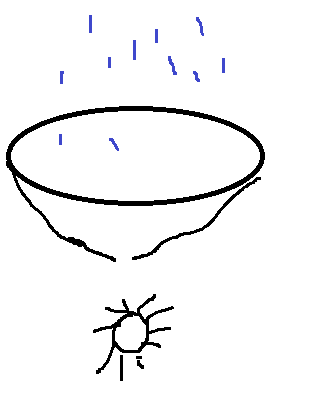- Joined
- Apr 29, 2011
- Messages
- 2,171
- Reaction score
- 863
TBR Physics I page 161
In this energy generator, rain (falling from a great height) is used to spin a turbine to generate energy.
I have 2 questions
1) Does the fact that rain is funnelled REDUCE the amount of energy generated? It seems to me that the rain that does not go through the small hole in the center (but that instead hits the funnel) loses a great amount of kinetic energy?
2) TBR says that increasing the number of paddles on the turbine to catch the water wouldn't help since it would increase mass and thus increase friction. But what about efficiency? Doesn't having more paddles increase the total net amount of water that is taken up. For example, if you have 5 paddles, you'll probably catch more of the total water than if you have 2 paddles.
3) I didn't show it but there are multiple turbines (imagine a second one just below the one I drew). TBR says (in question 27) that placing that turbines farther apart vertically would result in faster rotation of the turbines. But doesn't this decrease the amount of PE in the upper turbines (those closer to the sky)?

In this energy generator, rain (falling from a great height) is used to spin a turbine to generate energy.
I have 2 questions
1) Does the fact that rain is funnelled REDUCE the amount of energy generated? It seems to me that the rain that does not go through the small hole in the center (but that instead hits the funnel) loses a great amount of kinetic energy?
2) TBR says that increasing the number of paddles on the turbine to catch the water wouldn't help since it would increase mass and thus increase friction. But what about efficiency? Doesn't having more paddles increase the total net amount of water that is taken up. For example, if you have 5 paddles, you'll probably catch more of the total water than if you have 2 paddles.
3) I didn't show it but there are multiple turbines (imagine a second one just below the one I drew). TBR says (in question 27) that placing that turbines farther apart vertically would result in faster rotation of the turbines. But doesn't this decrease the amount of PE in the upper turbines (those closer to the sky)?

